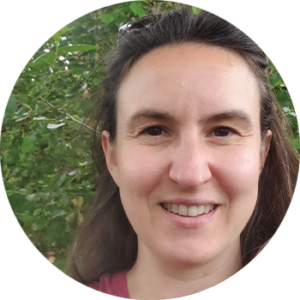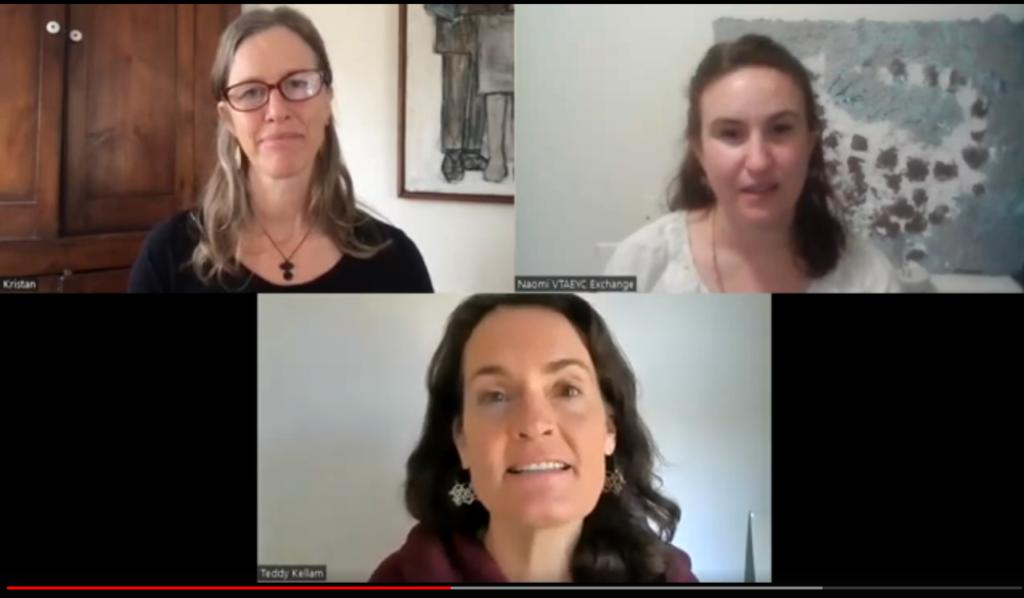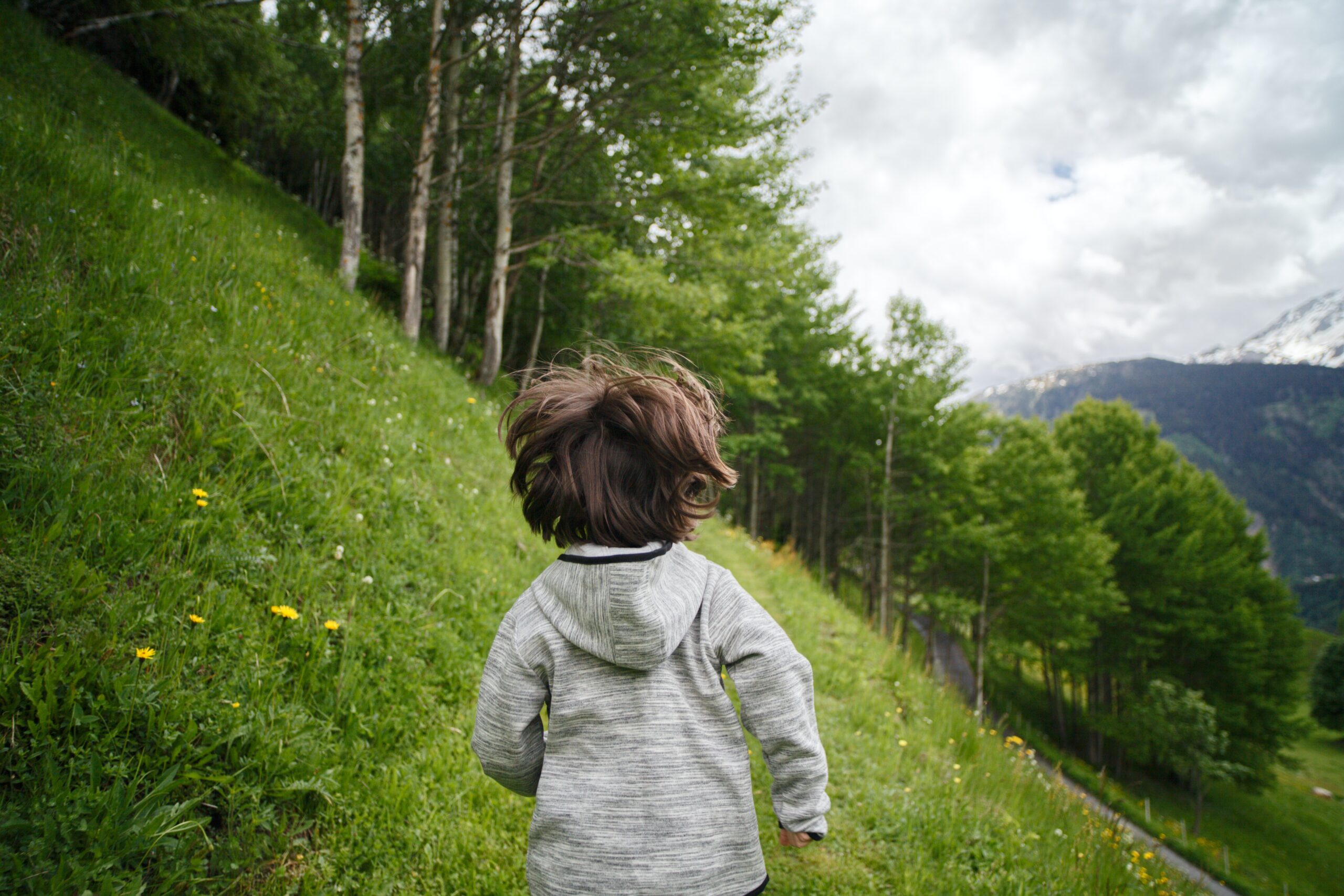by Naomi Alfini
Screenshot: Naomi Alfini interviews Kristan Klingelhofer and Teddy Kellam of the Good Grief Network. Video below and here.
The term climate anxiety, sometimes also called eco-anxiety, refers to anxiety that centers around the threats posed by climate change. A person with climate anxiety might feel compelled by specific concerns (like relentless heatwaves afflicting their family, livelihood or particular species they love), or by more generalized concerns (like the existential threats of mass extinction and an uninhabitable planet).
A common example of an experience of climate anxiety might be getting paralyzed in the grocery store. It’s more than a sense of indecision due to too many choices. When climate anxiety is involved, the overwhelm stems from a next-level, more personal crisis. One mother of young children described it to the New York Times (2022) as:
“’Standing in the snack aisle at Trader Joe’s, [hit by] a wave of guilt and shame.’ Something as simple as nuts. They came wrapped in plastic, often in layers of it, that she imagined leaving her house and traveling to a landfill, where it would remain through her lifetime and the lifetime of her children. Thinking of the disposable diapers in her cart, the plastic toys in her bathtub at home… it all made her anxious. She summed it up, ‘I feel like I have developed a phobia to my way of life.’ ”
nytimes.com
Why does a caregiver’s climate anxiety matter for young children?
Anxiety, stemming from any cause, obstructs our ability to feel safe and be present in the moment. That affects our experiences and relationships, including those with young children. And when we’re primary caregivers, that has implications for our young children’s development.
My own climate anxiety ratcheted up in 2017, when, nested with my partner and toddler in Vermont’s wet green mountains, I was following news of the wildfires in California, my childhood home. For weeks, my beloved redwood groves and vineyard communities burned while my loved ones slept in shifts with their evacuation bags ready at the door. And yet for many of the folks around me in Vermont, the climate crisis still felt far away. In the dissonance between what they couldn’t imagine and what I couldn’t stop imagining, I began to feel a deep sense of isolation and desperation.
For me, climate anxiety presented as doom-scrolling, insomnia, distraction, irritability, and frequent crying. Or, more aptly, intrusive crying. I’d be okay, going about my business making breakfast or reading bedtime stories, and then suddenly I’d be choking on tears. This affected my parenting. For example, when my four-year-old would excitedly talk to me about the Amazon rainforest (his new obsession, which coincided with a tsunami of wildfires in Brazil), I would find myself closing down – not only not matching his enthusiastic energy, but actively trying to shut off the conversation (and my feelings). Whereas I usually use his interests to support his growth and development, during that window I wasn’t available for it. Another example is how I couldn’t stay present with my family during special occasions like our winter holiday celebrations, consumed as I was with worry for climate refugees. Regardless of whether I managed to keep an even outer-appearance, I wasn’t authentically accompanying my loved ones in their joy and connection. The cumulative effect of my climate anxiety was a pervasive sense of stress that made it hard for me to show up as my best self – particularly during the daily moments of mundane parenting challenges – like a tricky morning transition out of the house. The whole process of dressing a toddler, finding my keys and remembering to bring all the things became messier and more fraught when I was already jacked up on adrenaline from thinking about how our children will fare in a future world of scarcity and conflict.
Discussing raising children in anxious times on her podcast, Unruffled Parenting, renowned parent educator Janet Lansbury, says “Children are always taking their tone from us. We’re the first point of safety for them. If we’re not there [in presence of mind and heart] it is much harder for them to feel comfortable.” Her guest in conversation, child therapist Susan Stiffelman, adds, “They watch us so carefully to decide how they should feel about something that happens that’s unexpected or difficult.” She goes on to give a personal example with her own son, “We might be facing something that to me was sort of, ‘Oh, my gosh, I can’t believe we’re dealing with this,’ and his focus was not on the situation but on me. Like to read me to see whether he should be worried…”.
This aspect of child development, how children attune to their caregivers’ cues about the world and their safety, is well-researched. Studies even show evidence that stress can be passed on physiologically – like how an infant’s heart rate raises to match their mother’s, once reunited with her after she has a negative experience. Though much of the research focuses on mothers and children, experts expand the term “caregiver” to describe any adult who provides primary care and support to a child including fathers, guardians, teachers and child care providers.
Thus, when we’re anxious in the company of our children, they’re at risk of taking on the anxiety for themselves. My own son didn’t know the Amazon was burning and losing species he loved from Octonauts. He may not have realized it was mention of the jungle, specifically, that had me seizing up. But he knew something was wrong. Something was striking a different chord in me, breaking the sense of our harmony in the world. He sensed my fear and dysregulation.
Regulating our emotions
Regulation, or self-regulation, can be defined as the ability to monitor, recognize and manage our thoughts and feelings as they happen, so as to experience, express and act with appropriate response to each situation. Emotional dysregulation, on the other hand, is having poorly regulated emotional responses, which can show up as overly intense emotions, impulsive behavior, lack of emotional awareness, trouble making decisions, inability to manage emotions, and avoiding difficult feelings. In children, emotional dysregulation often presents as temper tantrums, outbursts, crying, refusing to make eye contact or speak, etc. Children develop regulation skills through the experience of co-regulation, which is the process by which primary caregivers provide external support to help them regulate their emotions during distress. Caregivers co-regulate with infants and toddlers by paying close attention and responding quickly to children’s cues, comforting them physically (e.g. hug) and emotionally (e.g. speaking), removing them from stressful situations, and modeling self-regulating strategies like mindful breathing. As young children grow, caregivers also coach them to label, learn and talk about their feelings and simple problem-solving skills.
The great opportunity of co-regulation, Stiffelman points out, is that it gives us “a lot of power or ability to quell [children’s] anxieties by regulating ourselves, and by managing our own fears and worries in an appropriate way with other adults.” She suggests that when we model meeting trouble with calm we communicate something like: “There are things that we haven’t figured out yet, but I’m solid and we’ll get through this”.
But how do we regulate ourselves? According to Duke’s Center for Children and Family Policy, to co-regulate successfully, caregivers need to 1) pay attention to their own feelings and reactions during stressful interactions with a child, 2) pay attention to their own thoughts and beliefs about the behaviors of others, and 3) use strategies to self-calm and respond effectively and compassionately. Easier said than done if we are currently struggling. Therefore, Stiffelman says an important part of the process is “getting support in ways that help us, finding good sources of guidance online or within our communities and friendships.”
Getting support
Last fall I joined an online support group for caregivers struggling with climate anxiety through Good Grief Network – a nonprofit that creates “spaces to gather in community, process the painful feelings and realities of our time, and commit to meaningful action”. For ten weeks, for a couple of hours each week, I met with a group of 12 other parents for a series of guided discussions and activities. Co-facilitators Kristan Klingelhofer and Teddy Kellam offered us a rich collection of tools for understanding and managing our emotions and actions in relation to climate change, parenting, and stewardship. One such useful tool for thinking about regulating and co-regulating emotions is a visual, called the Hand Model (or Hinge Theory), developed by psychiatrist and author Dan Siegal. Klingelhofer discusses the model in an interview I did with her and Kellam [see video below and here]. I will provide a brief summary here.
The hand model represents the two main parts of the brain involved in processing emotions. It works like this: if you make a fist with your thumb tucked in, it resembles a side view of the brain. Your thumb represents the limbic system (the social emotional center that is physically located at the center of the entire brain) and the fingers folded over it would be the prefrontal cortex (the executive center, or “thinking brain” responsible for reasoning, patience, cooperation and impulse control). The limbic system constantly tracks the nonverbal language and the social cues in the room to know “Am I safe?” For young children, safety also entails a question about primary social connection: “Am I at the forefront of anybody’s mind?” The limbic system gets priority in the brain. To access our prefrontal cortex, with all its higher order thinking and learning, our limbic system must first feel attuned and safe.
If instead the limbic system senses danger for our safety or belonging, the circuit to the prefrontal cortex is cut off. It literally receives less blood flow. This can send us into flight/fright/freeze. Imagine the fingers lifted up, like a lid has hinged open. In children, Siegal refers to this state as when the child has “flipped their lid”. Klingelhofer says this is why when a child’s having a tantrum, they can’t hear you explain a solution. They’re “not in that part of their brain”. For adults, when we get to this state, we want to notice what we’re feeling and take steps to regulate ourselves to deal most effectively and co-regulate with our children.
For developing young children, Klingelhofer points out the disconnection can be caused by something big, like a sibling being born, or small, like a parent sneaking off from play to answer the phone. The goal, she says, “is not to prevent disconnection or prevent kids from flipping their lid. That is gonna happen many times. Siblings are born. Parents have to answer the phone. What you want is for this mechanism [of closing the lid back down, or returning to regulation] to be familiar. You want a really strong hinge… And we lay the path work for this motion with the way we handle our children when they’re upset.”
She continues: “In our culture we try to keep our kids from showing us they’re upset. We want them to keep their lid down. [But] we need this paradigm shift that them showing us their feelings [is good] – that it is, in fact, their built-in healing mechanism. They can heal themselves if we can hold the process well…. We want to start seeing that, if our children are off-track – whiny, rude, sullen, have to have things just so – they’re really just signaling to you: I’m not okay in here. And they just need a warm and loving limit so they can cry and release these pent-up feelings so that they can get back to their connected brain. When your child is having big feelings, what I suggest is that you take a breath yourself, move in close and with some warmth, and some optimism about their innate goodness, stop their behavior, gently, if you need to, and then just offer your connection in that moment. As they’re offloading all these big feelings, you’re just pouring in your warmth, calm and your faith in them, and that they can heal….
If we can approach kids with this understanding, we will raise children who aren’t so brittle when they get upset. They’re not so reactive. They’ll flip their lids, but after borrowing our brain, our calmness in the moment so many times, they learn to access that on their own overtime…. It\’s not that they won’t be distressed, they will. Referring to climate change and the world children are coming into – there’s so much uncertainty. There will be fires. There will be stresses. And so the goal can’t be that we avoid hardship, that’s too fragile. The goal is that, with this way to help children heal and get back to their brain, it will help them be resilient, empathetic, creative, clear-thinking people who can plan long term and even be joyful in the face of it. This is some of the deepest activism we can be doing as parents, as early childhood educators, this is laying the groundwork that is going to be so important for whatever we’re going to be facing in the future. I would call it climate activism.”
For me, the thought that by working on my own regulation skills, I am doing something important to help the children in my care deal with a future of climate change, makes me feel better, and less anxious. I will discuss more about my experience with GGN in my next blog post. In the meantime, please check out the video/audio of my interview with Klingelhofer and Kellam to hear their thoughtful, wise discussion about working with climate anxiety and grief in ourselves, and with children.
- “Climate Change Enters the Therapy Room”, article by Ellen Barry, The New York Times, Published Feb. 6, 2022. nytimes.com/2022/02/06/health/climate-anxiety-therapy.html
- “Presence, Parenting and The Planet”, a videoed presentation by Dan Siegel, Talks at Google, June 10, 2019. youtube.com/watch?v=Ouzb_Urt7LQ
- “Parenting in Anxious Times, with Susan Stiffelman, MFT”, episode on the podcast Unruffled Parenting, by Janet Landsbury, March 2020. janetlansbury.com/2020/03/parenting-in-anxious-times-with-susan-stiffelman-mft/
- “Self-Regulation and Toxic Stress Series”, online repository of reports and policy briefs for the Office of Planning, Research and Evaluation, an office of the Administration for Children and Families, 2013 – 2022. acf.hhs.gov/opre/project/self-regulation-and-toxic-stress-series
- “Is Stress Contagious? Study Shows Babies Can Catch It from Their Mothers”, article by Juliana Bunim, University of San Francisco, Feb. 6, 2014.
ucsf.edu/news/2014/02/111661/stress-contagious-study-shows-babies-can-catch-it-their-mothers
- “Co-Regulation From Birth Through Young Adulthood: A Practice Brief”, Duke Center for Child and Family Policy for the Administration for Children and Families (ACF), & The Office of Planning, Research and Evaluation (OPRE), July 20, 2020. fpg.unc.edu/sites/fpg.unc.edu/files/resources/reports-and-policy-briefs/Co-RegulationFromBirthThroughYoungAdulthood.pdf
- “Emotional Regulation in Children: A Complete Guide”, Pamela Li, Dec 21, 2022, parentingforbrain.com/self-regulation-toddler-temper-tantrums/
- “What Is Dysregulation?” article by Arlin Cuncic, on the website Very Well Mind, Nov 14, 2022. verywellmind.com/what-is-dysregulation-5073868
- “How Co-regulation with Parents Develops into Self-Regulation in Children,” article by Pamela Li, Nov 4, 2022, parentingforbrain.com/co-regulation/?utm_source=rel&utm_medium=regulate
- “Co-Regulation From Birth Through Young Adulthood: A Practice Brief”, Duke Center for Child and Family Policy for the Administration for Children and Families (ACF), & The Office of Planning, Research and Evaluation (OPRE), July 20, 2020. fpg.unc.edu/sites/fpg.unc.edu/files/resources/reports-and-policy-briefs/Co-RegulationFromBirthThroughYoungAdulthood.pdf
(*same as reference #6)
- Good Grief Network, website 2023, goodgriefnetwork.org
- “Presence, Parenting and The Planet”, a videoed presentation by Dan Siegel, Talks at Google, June 10, 2019. youtube.com/watch?v=Ouzb_Urt7LQ
(*same as reference #2)

Naomi Alfini is a VTAEYC Exchange Fellow with a focus on Our Planet x Young Children. Click here to learn more about Naomi and the Fellowship program, and click here to learn more about the VTAEYC Exchange.
The Exchange is recruiting our next cohort of Fellows. Learn more, share this opportunity, and apply today!


